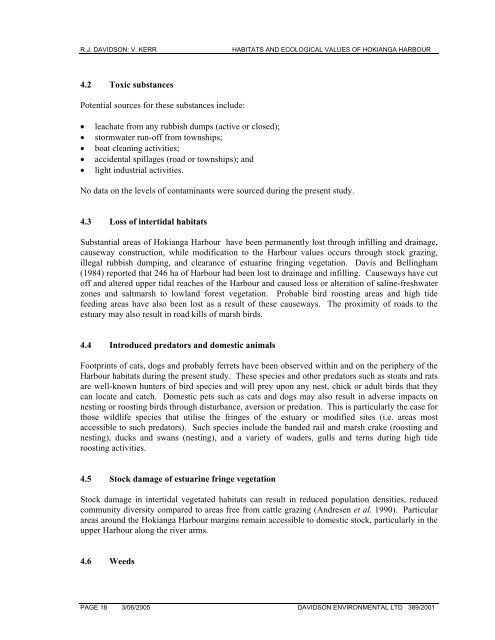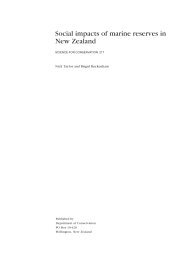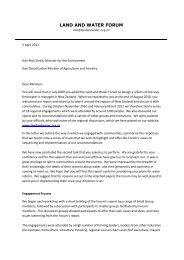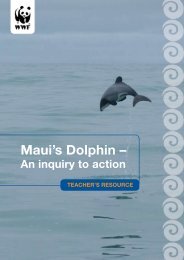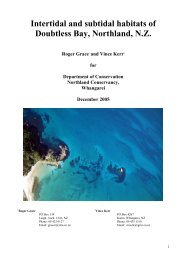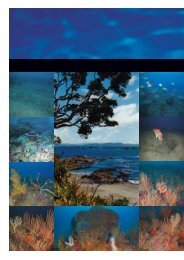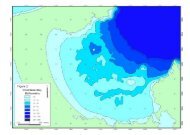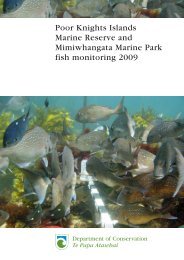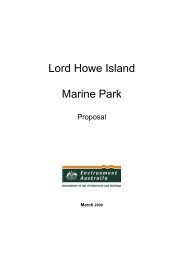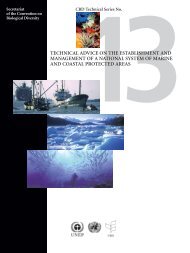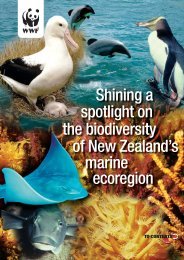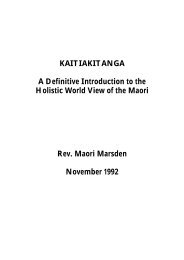Habitats and Ecological Values of the Hokianga ... - MarineNZ.org.nz
Habitats and Ecological Values of the Hokianga ... - MarineNZ.org.nz
Habitats and Ecological Values of the Hokianga ... - MarineNZ.org.nz
Create successful ePaper yourself
Turn your PDF publications into a flip-book with our unique Google optimized e-Paper software.
R.J. DAVIDSON: V. KERR<br />
HABITATS AND ECOLOGICAL VALUES OF HOKIANGA HARBOUR<br />
4.2 Toxic substances<br />
Potential sources for <strong>the</strong>se substances include:<br />
• leachate from any rubbish dumps (active or closed);<br />
• stormwater run-<strong>of</strong>f from townships;<br />
• boat cleaning activities;<br />
• accidental spillages (road or townships); <strong>and</strong><br />
• light industrial activities.<br />
No data on <strong>the</strong> levels <strong>of</strong> contaminants were sourced during <strong>the</strong> present study.<br />
4.3 Loss <strong>of</strong> intertidal habitats<br />
Substantial areas <strong>of</strong> <strong>Hokianga</strong> Harbour have been permanently lost through infilling <strong>and</strong> drainage,<br />
causeway construction, while modification to <strong>the</strong> Harbour values occurs through stock grazing,<br />
illegal rubbish dumping, <strong>and</strong> clearance <strong>of</strong> estuarine fringing vegetation. Davis <strong>and</strong> Bellingham<br />
(1984) reported that 246 ha <strong>of</strong> Harbour had been lost to drainage <strong>and</strong> infilling. Causeways have cut<br />
<strong>of</strong>f <strong>and</strong> altered upper tidal reaches <strong>of</strong> <strong>the</strong> Harbour <strong>and</strong> caused loss or alteration <strong>of</strong> saline-freshwater<br />
zones <strong>and</strong> saltmarsh to lowl<strong>and</strong> forest vegetation. Probable bird roosting areas <strong>and</strong> high tide<br />
feeding areas have also been lost as a result <strong>of</strong> <strong>the</strong>se causeways. The proximity <strong>of</strong> roads to <strong>the</strong><br />
estuary may also result in road kills <strong>of</strong> marsh birds.<br />
4.4 Introduced predators <strong>and</strong> domestic animals<br />
Footprints <strong>of</strong> cats, dogs <strong>and</strong> probably ferrets have been observed within <strong>and</strong> on <strong>the</strong> periphery <strong>of</strong> <strong>the</strong><br />
Harbour habitats during <strong>the</strong> present study. These species <strong>and</strong> o<strong>the</strong>r predators such as stoats <strong>and</strong> rats<br />
are well-known hunters <strong>of</strong> bird species <strong>and</strong> will prey upon any nest, chick or adult birds that <strong>the</strong>y<br />
can locate <strong>and</strong> catch. Domestic pets such as cats <strong>and</strong> dogs may also result in adverse impacts on<br />
nesting or roosting birds through disturbance, aversion or predation. This is particularly <strong>the</strong> case for<br />
those wildlife species that utilise <strong>the</strong> fringes <strong>of</strong> <strong>the</strong> estuary or modified sites (i.e. areas most<br />
accessible to such predators). Such species include <strong>the</strong> b<strong>and</strong>ed rail <strong>and</strong> marsh crake (roosting <strong>and</strong><br />
nesting), ducks <strong>and</strong> swans (nesting), <strong>and</strong> a variety <strong>of</strong> waders, gulls <strong>and</strong> terns during high tide<br />
roosting activities.<br />
4.5 Stock damage <strong>of</strong> estuarine fringe vegetation<br />
Stock damage in intertidal vegetated habitats can result in reduced population densities, reduced<br />
community diversity compared to areas free from cattle grazing (Andresen et al. 1990). Particular<br />
areas around <strong>the</strong> <strong>Hokianga</strong> Harbour margins remain accessible to domestic stock, particularly in <strong>the</strong><br />
upper Harbour along <strong>the</strong> river arms.<br />
4.6 Weeds<br />
PAGE 18 3/06/2005 DAVIDSON ENVIRONMENTAL LTD 389/2001


